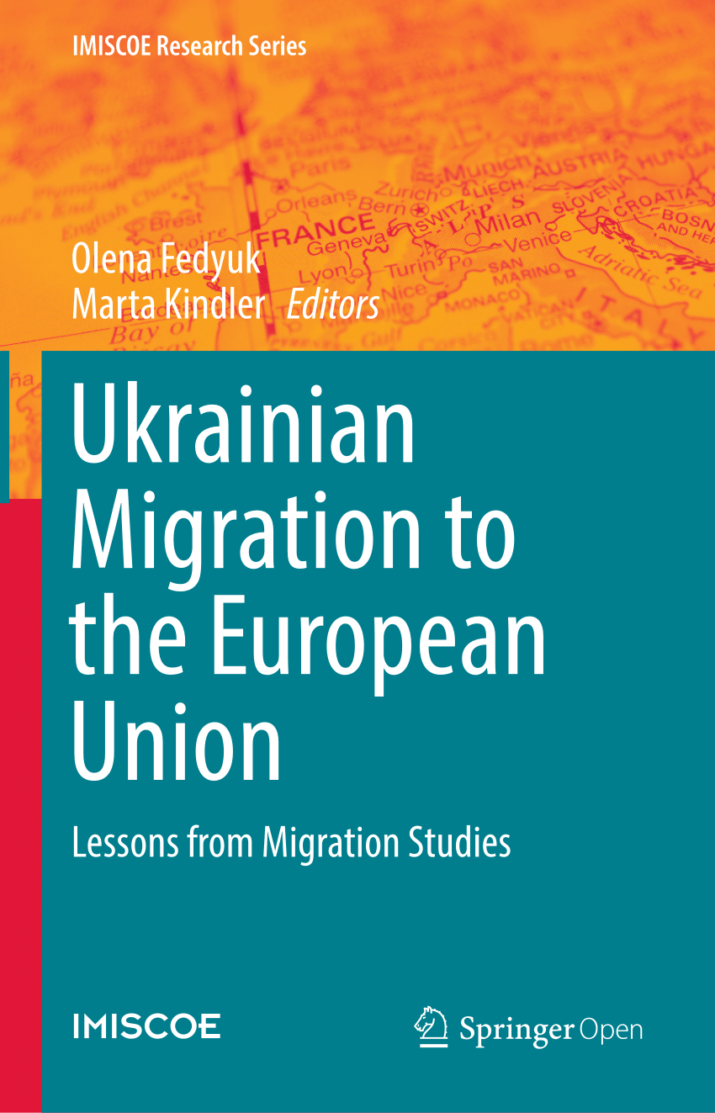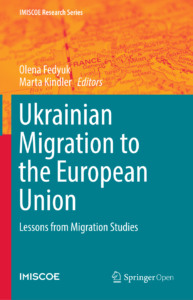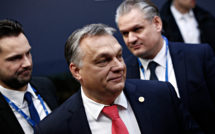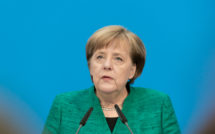
Ukrainian Migration to the European Union: Lessons from Migration Studies by Olena Fedyuk and Marta Kindler
 Ukrainian Migration to the European Union: Lessons from Migration Studies is a multidisciplinary edited volume that consists of diverse aspects of migration of Ukrainian nationals to the EU (theoretical, historical, legal framework) and of particular national cases (Ukrainians in Poland, Czech Republic, Greece, Italy, Spain, Portugal, and the USA). The book is divided into two parts and those parts consist of thirteen chapters altogether. The first part of the volume is an analytical review of literature on migration studies that are related to Ukraine. It includes chapters with a historical retrospective of migration flows from Ukraine before and since 1991; economics and policy analyses of migration to EU; a review from gender perspective; and a chapter on the definitions and sociological predictions of immigration.
Ukrainian Migration to the European Union: Lessons from Migration Studies is a multidisciplinary edited volume that consists of diverse aspects of migration of Ukrainian nationals to the EU (theoretical, historical, legal framework) and of particular national cases (Ukrainians in Poland, Czech Republic, Greece, Italy, Spain, Portugal, and the USA). The book is divided into two parts and those parts consist of thirteen chapters altogether. The first part of the volume is an analytical review of literature on migration studies that are related to Ukraine. It includes chapters with a historical retrospective of migration flows from Ukraine before and since 1991; economics and policy analyses of migration to EU; a review from gender perspective; and a chapter on the definitions and sociological predictions of immigration.
The second part is divided into chapters whereby each provides an empirical study of Ukrainian migration in various EU countries. Each chapter is not constructed by the same methodology and does not answer the same questions. “Ukrainian migration to the EU” is rather an umbrella title that includes diverse scientific questions and even more vivid analysis. Thus, the chapter on Poland (Z. Brunarska, M. Kindler, M. Szulecka, S. Torunczyk-Ruiz, Chaper 7, 115-131) seeks to analyze the socio-demographic characteristics, regions of departure and arrival, and types of work Ukrainian migrants are engaged in. The study is based here on official statistical data that the authors analyze.
The authors have included material on migration flows in the context of the post-Maidan situation. It is an interesting phenomenon where further explanations will benefit a deeper understanding of the migration strategies of Ukrainians to Poland.
The next chapter, “Ukrainians in the Czech Republic” by Y. Leontiyeva (Chapter 8, 133-149) has similarities with the Polish case in terms of methodological background and brief historical review, but generally is trying to describe the phenomenon of how and why Ukrainians became the largest group among migrants in the country. It also depicts the dynamics of migration flow that are related to the policy changes. Y. Leontiyeva demonstrates how, due to the rigid policies the inflow of Ukrainian migrants to Czechia has practically stopped in 2008.
The following chapters on Greece (M. Nikolova, M. Maroufof, Chapter 9, 151-162), Italy (F.A. Vianella, Chapter 10, 163-178), and also on Spain (M.Stanek, R. Hosnedlova, E.Brey, Chapter 12, 193-214) are united by the gender aspects that all of them analyze. The gender imbalance of Ukrainian migrants coming to work in the EU is their point of departure.
Chapter 11 (M.L.Fonseca, S. Pereira, 179-192) examines the phenomenon of Ukrainian immigration to Portugal. It is characterized by a rapid and extensive flow, which emerged at the end of 1990s and cannot be explained by traditional exploration models. If other locations, such as Poland or the Czech Republic, had a longstanding and historical relevance, or if the flow was rather new, like in Italy, Spain, or Greece, it would not constitute sudden migratory movement. Immigration of Ukrainian citizens to Portugal cannot be explained by existing models. The authors highlight that in 1996 there were only seventy-one Ukrainian citizens registered in Portugal, by 2002 this number had risen to 66,448 Ukrainian citizens (Fonseca, Pereira, 179). Moreover, Ukrainians have constituted the third-largest minority in the country after Brazil and Cape Verde (both of which have clear post-colonial ties).
Not only the number, but also a vivid geographical dispersal was a new pattern discovered by the authors. If the majority of other migrant groups have usually settled in the area of Lisbon, Ukrainians have moved over the different territories, even those that had experienced by a very low number of immigrants before.
As in other national cases, many Ukrainian immigrants in Portugal are usually over-qualified for jobs. Upon arrival, many find jobs in construction, industry, and agriculture. Referring to a long-term study of Ukrainians in Portugal, authors have discovered that more than 70 percent of respondents had different occupations compared to what they had upon arrival. Moreover, some people (around 20 percent) have become small employers or independent workers, and have continued to increasingly invest in small business in Portugal “to overcome situations of exploitation in the labor market” (Fonseca, Pereira, 187).
The last chapter (Chapter 13, C.D. Solari, 215-227) is focused on theorizing Ukrainian migrants in Italy and the US. It is based on a methodology of “global ethnography” and includes a large number of in-depth interviews (158) and participant observations. The geography of analysis also differs from the other studies collected in the book. The author looks at migration patterns to Italy and to the USA and takes Rome and San Francisco into consideration as cities for analysis.
Solari constructs a new trajectory of Ukrainian migration by re-framing the focus of observation on the dynamic relationship of both sending and receiving countries. What she offers is not merely a focus on the singular phenomenon (either sending or receiving country), but noticing how the relocation process shifts both sites of flow. The existence of a gender imbalance is very vividly demonstrated in many of the chapters in this book. Italy presents a special case with its extensive female majority and gender-determined professional path. Women constitute more than 80 percent of all migrants, usually being employed in the care and domestic sector (Vianello, 174). Poland, the Czech Republic, and Greece have similar patterns with a gender imbalance that has clear correlation to the demands of the local labor market. However, the authors mention that the situation has changed in recent years and the number of men arriving in those counties has increased. In many cases, this is the result of families reuniting—men and/or children who usually stayed in Ukraine, reuniting with “mothers” and “wives” who have been working in Europe. Thus, according to Stanek at al. (Chapter 12) around 44.5 percent of Ukrainians living in Spain have families and more than 30 percent of migrants brought all their children there. Similar data is provided for the Portugal case, where almost 30 percent of Ukrainian migrants have arrived to the country on the basis of family reunion (Chapter 11). If migration to the EU is dominated by female migration, the Eurasian flow is diametric, whereby more than 80 percent of migrants to Russia are men employed in construction, mining and city transportation (Fedyuk, 74). The overall number of migrants has changed throughout the years, depending on the political and economic situations both in departure- and arrival-countries.
There is a set of newly arisen problems that emerged as a result of temporal emigration from Ukraine. One of the most important is the fragmentation of families and the transformation of family relations. Studies show that instead of a transformation of family roles, child care, in a number of cases, is simply delegated to female relatives (grandmothers in the majority of cases) and thus expand the family network but prioritize traditional continuity and also re-actualize the role of grandmotherhood in the family chain (Fedyuk 76). Another aspect that should be further studied is the role of employment agencies in structuring temporary forms of migration, especially to Southern and Northern Europe (Gorny, Kindler, 107).
This book, which expands professional horizons by providing extensive and vivid data, with observed phenomena and with the most recent case studies, simultaneously provides even more questions to be answered. Study on Ukrainian migration requires more systemic cross-country analysis and needs a greater focus on male migration. Embracing other categories of migrants, such as academia, higher-middle class, groups of various alternative life styles, and LGBT+ various groups, would play a beneficial role in investing more nuanced studies on Ukrainian migration to Europe and beyond.
What remains is the problem of imbalance in studying female migration, which is characterized by a predominance of nuanced attention to female migration and low attention to male migration or any other form of analysis. This volume is no exception. This tendency is also pointed out by one of the book editors, Olena Fedyuk, who reminds the reader that even in Poland, which has a more gender-balanced migration structure, female migration cases are more diligently represented (Fedyuk, 77). The study of migrants’ children, family chains and the transnational families where one of the partners has Ukrainian origin would also be of high importance to further development of the studies on migration.
In general, “Ukrainian Migration to the European Union” is a challenging collection of interdisciplinary and transnational research on Ukrainian migrants in Europe, with extensive presentation of trends, features, observations, and multiple methodological perspectives. Olena Fedyuk and Marta Kindler, the editors, have made an immense work by collecting all the materials into a clear and consonant story. To a certain degree, it could be perceived as a compendium on migration studies with the focus on Ukraine as a country of departure, and it would be of much interest to scholars/practitioners from diverse disciplines dealing with migration within the European Union and beyond.
Reviewed by Alina Zubkovych, Södertörn University
Ukrainian Migration to the European Union: Lessons from Migration Studies by Olena Fedyuk and Marta Kindler
by Olena Fedyuk and Marta Kindler (Eds.)
Publisher: Springer Open
Hardcover / 230 pages / 2016
ISBN: ISBN 978-3-319-41776-9
Published on July 5, 2018.




